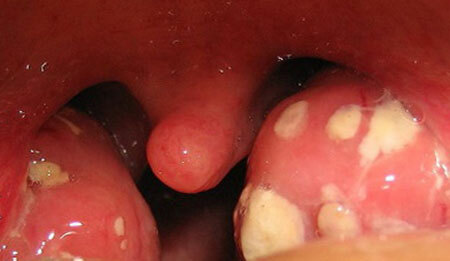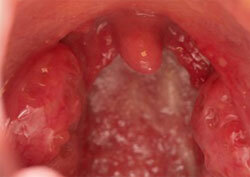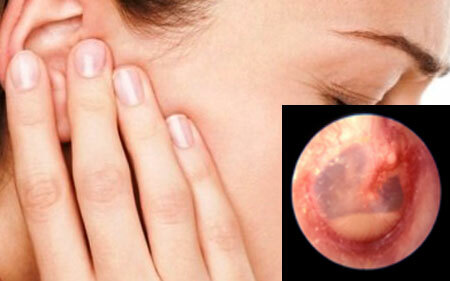The mucosa of the oral cavity and throat should be pink in color, shiny, with no inclusions and foreign particles. The appearance of white, gray or yellow spots is not considered normal and indicates the occurrence of the disease.
Most often these areas of pus accumulation formed by the body in response to microbial infection and inflammation.
Contents
- 1 Causes of pus in the throat, symptoms of diseases, photos
- 2 Pus in the throat in the child - features
- 3 Diagnosis of diseases with the appearance of pus in the throat
- 4 Methods of treatment of pus in the throat
Causes of pus in the throat, symptoms of diseases, photos

Purulent deposits in the throat,photo
There are several reasons for the appearance of pus:
- The most common cause is tonsillitis: acute angina( follicular, lacunar), chronic tonsillitis.
- Inflammatory diseases of the sinuses of the nose: sinusitis, sinusitis.
- Diphtheria.
- Development of purulent inflammation with a foreign object in the nose.
Pus in the throat is a frequent companion of angina and chronic tonsillitis, however, its appearance with these ailments is accompanied by other symptoms.

Purulent coating, photo of throat
Acute angina develops in a short time, starts suddenly with sore throat, poor health, fever.
In the lacunar form, pus films appear in the area of the indentations on the tonsils( lacunae).When rinsing or under mechanical influence( for example, a cotton swab), the pus is easily removed.
Follicular angina is called inflammation in the follicles of the tonsils. In addition to redness and swelling of the tonsils, there is an appearance of pus, which appears in the form of small grains. This is the inflamed follicles.
Over time, small abscesses can open themselves, the pus flows into the pharynx or mouth cavity, which causes an unpleasant taste in the mouth and smelly odor from the mouth.
In acute forms of sore throat, the appearance of pus in the throat occurs with an increased body temperature( up to 40 ˚С) and disability due to the expressed intoxication syndrome.
Chronic tonsillitis is the presence of infection in the tissue of the tonsils, which can be in a dormant state for a long time, and with a decrease in immunity give exacerbations, manifested by inflammation and the formation of purulent plugs.
This is the result of previous acute angina that was not treated adequately and the source of infection remained.
Pus in the throat with chronic tonsillitis can appear without a rise in temperature, the general condition may suffer slightly.
More often the patient only notes a sore throat. On examination, enlarged palatine tonsils are visible, lacunae are blocked by purulent masses, from the mouth there is an unpleasant smell of decaying tissues.
Diphtheria - purulent plugs are easily confused with the formations in the pharynx with diphtheria, which are very similar in appearance. Diphtheria is considered a child's disease, it is very difficult with high fever and sore throat. On tonsils appear films of gray or yellow color, which resemble pus.

Kind of throat for diphtheria, photo
The peculiarity of these spots is their tight connection with the mucous membrane. In diphtheria, the plaque does not disappear after rinsing and mechanical action on them. When trying to clean the film with a spatula or improvised materials, bleeding of the mucosa at the spot of spot formation is noted.
In severe cases, films cover not only the tonsils, they can be found in any part of the mouth. The disease is dangerous development of edema of the larynx and soft tissues of the neck, which threatens to stop breathing.
With a large number of films, there is a high likelihood of plugging the larynx and disturbing normal breathing. In diphtheria, the child should be hospitalized urgently for specific therapy.
With inflammation of the sinuses of the skull ( sinusitis), pus has a peculiarity to drain into the throat. In a chronic process, the general symptoms of the disease can be mild, the patient complains only of the taste of pus in the mouth and the smell from the mouth, which is not eliminated by the use of toothpastes and rinse.
Often purulent discharge coughs up in the form of clots of yellow color.
Pus in the throat of a child - features of

Pus in the throat of a child, photo of
examination The appearance of pus in the throat of a child without previous severe symptoms can often indicate the presence of a foreign object in the nose or nasal sinuses.
Young children like to experiment with small toys and objects, thrusting them into the natural openings of their body. Parents do not always notice this.
After some time, inflammation develops at the location of the foreign body, and if the mucous membrane is damaged, secondary infection is associated with the development of purulent inflammation. This happens particularly quickly if the small object has uneven or sharp edges.
Mom and Dad can notice that the child has an unpleasant smell from the mouth, and when examining the throat, pus can be seen on the back wall. This indicates that the purulent exudate flows into the oropharynx.
If the object is located in the nasal passage low, then the purulent discharge can also go through the nose, imitating the runny nose. However, the allocation will only be from the nostril in which the object is located. For the common cold, the unilateral course from the nose is not characteristic.
Diagnosis of diseases with the appearance of pus in the throat
If you find one of the above symptoms, you should contact an ENT doctor for a detailed examination and diagnosis.
At the stage of diagnostics, the activities are quite simple and painless:
- Throat examination, or pharyngoscopy.
- Blood tests to confirm the inflammatory process in the body.
- Take a smear from the tonsils for further seeding to determine the type of pathogen and determine its sensitivity to antibiotics.
Treatment methods for pus in the throat

Treatment is performed only after confirmation of the diagnosis. Methods of treatment should be directed at the cause of the disease - infection. Basically, these are conservative methods, which can include the following:
- Antibiotic therapy. The doctor prescribes antibacterial drugs from those groups to which the causative agent of the disease is susceptible.
- In chronic tonsillitis, purulent plugs are removed by washing the lacunae of the tonsils. It is carried out with a syringe or on a special apparatus "Tonzillor" with the use of antiseptic solutions. The method promotes the fastest recovery and prolongs the period of remission, thanks to the removal of the pathogen and dead cells from the depressions of the tonsils.
- After cleansing, lacunas are administered medications in the form of ointments, pastes.
- Self-rinsing with antiseptics or infusions of herbs.
- If a foreign object is found in the area of the nose, its extraction is performed and preparations are prescribed for the healing of the mucous membrane.
- Immunomodulating drugs.
- Physiotherapy procedures that accelerate the healing process and relieve inflammation.
If purulent plugs do not lend themselves to conservative methods of treatment, a tonsillectomy surgery is prescribed.
If possible, try to avoid surgical intervention, as the palatine tonsils provide a filter function, rendering harmless the air and food. But at the same time, chronic inflammation in the throat can spread to other organs: the heart, joints, kidneys.
Tonsillectomy is performed according to strict indications, when the risk of complications to internal organs exceeds all others.



